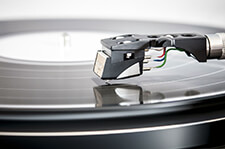Analog
Analog is an adjective that describes a continuous measurement or transmission of a signal. It is often contrasted with digital, which is how computers store and process data using ones and zeros.
While computers are digital devices, human beings are analog. Everything we perceive, such as what we see and hear, is a continuous transmission of information to our senses. This continuous stream of input is not estimated, but received and processed by our brains as analog data.
Analog vs Digital Equipment
Though we live in an era called the "digital age," many analog devices still exist. For example, a turntable (or record player) is an analog device, since the needle continuously reads the bumps and grooves on a record. Conversely, a CD player is digital since it reads binary data that represents an audio signal. A thermometer that displays the temperature using a mercury level or needle is considered analog, while one that displays the temperature on a screen is digital.
While analog data has its advantages, digital data is far easier to manage and edit. Since computers only process digital data, most information today is stored digitally. Digital data is also easier to duplicate and preserve. An exact copy of a CD or hard drive can be created over and over again, while copying an analog tape will eventually degrade the quality.
Converting between Analog and Digital
It is possible to convert analog data to digital and vice versa. For example, you can use an analog-to-digital converter (ADC), to convert analog VHS tapes into digital movies that can be played on your PC. Similarly digital audio data can be converted to an analog signal that can be played through a speaker. This is done using a digital-to-analog converter (DAC), which may exist in either the playback device (such as a computer) or the speaker.
NOTE: If a speaker receives a digital input (such as a USB or Toslink connection), it must use a built-in DAC to convert the signal to analog. If it receives an analog input, such as a 1/8" audio cable, RCA jack, or speaker wire, the analog signal can be output directly through the speaker.
 Test Your Knowledge
Test Your Knowledge